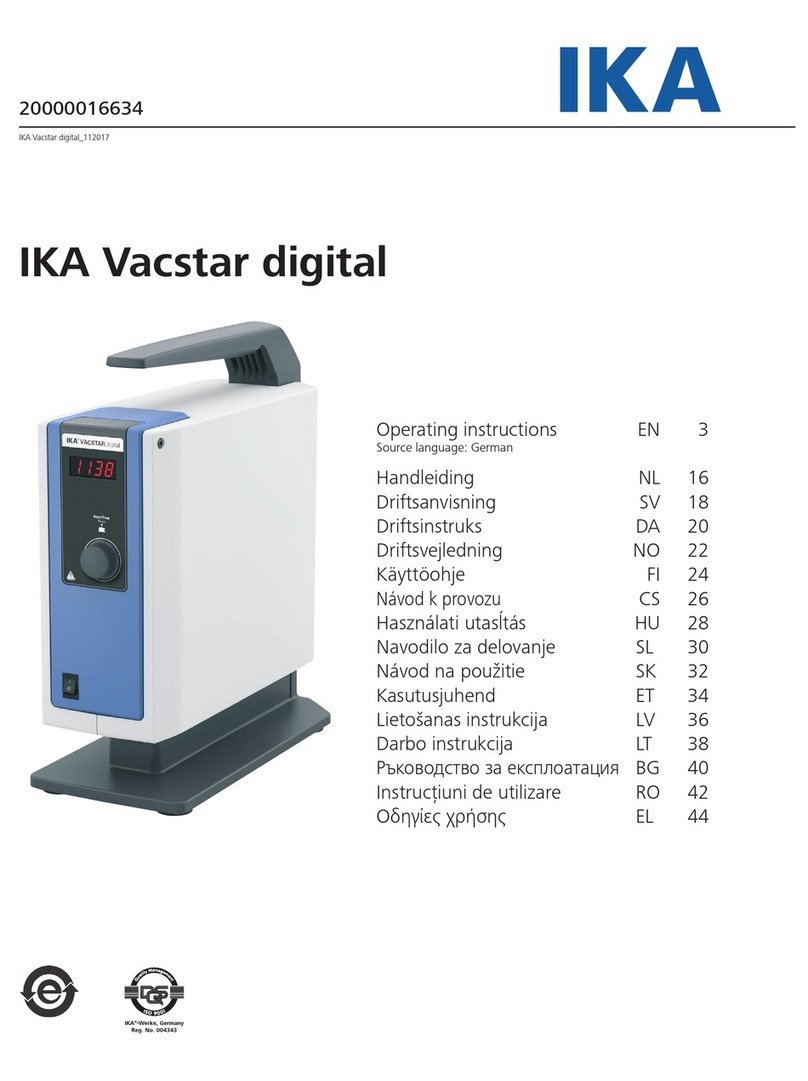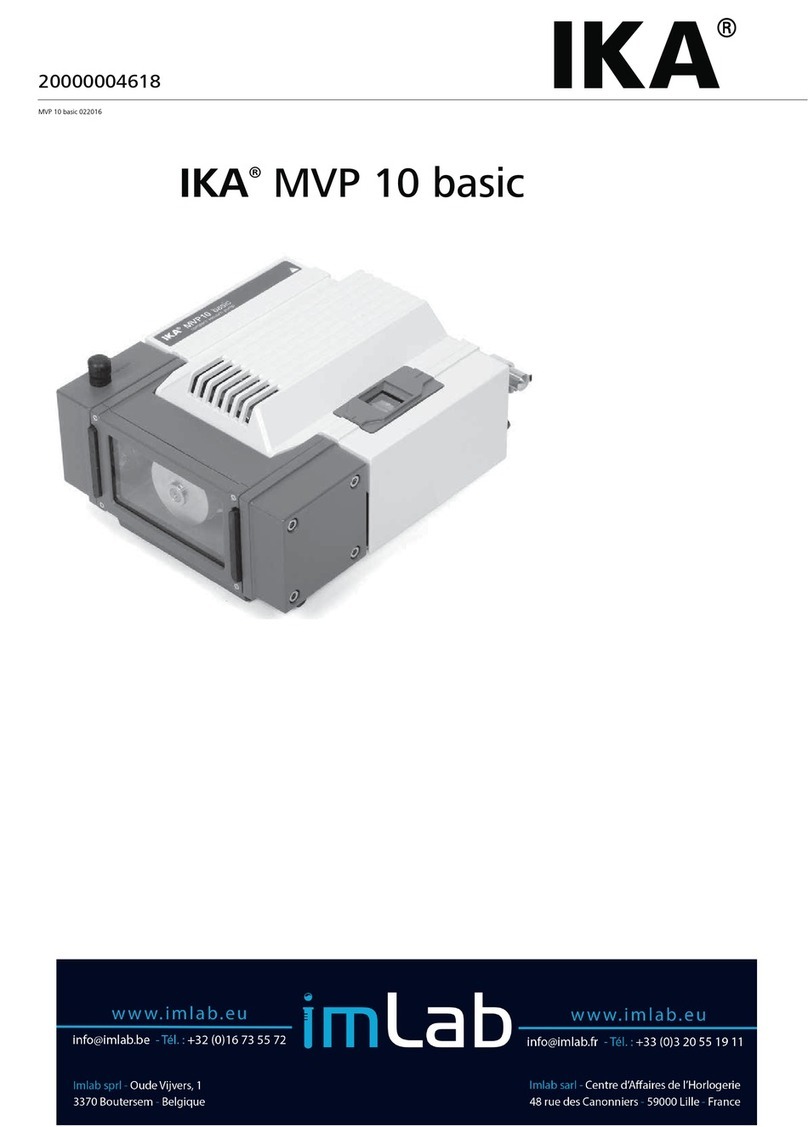
54
• Lesen Sie die Betriebsanleitung vor Inbetriebnah-
me vollständig und beachten Sie die Sicherheits-
hinweise.
• Bewahren Sie die Betriebsanleitung für alle zugänglich
auf.
• Beachten Sie, dass nur geschultes Personal mit dem Gerät
arbeitet.
•
Beachten Sie die Sicherheitshinweise, Richtlinien, Arbeits-
schutz- und Unfallverhütungsvorschriften.
•
Tragen Sie Ihre persönliche Schutzausrüstung entspre-
chend der Gefahrenklasse des zu bearbeitenden Mediums.
Ansonsten besteht Verletzungsgefahr durch Glasbruch.
Die Pumpe nicht bei offener Front-
abdeckung betreiben. Ansonsten
besteht die Gefahr schwerer Ver-
letzungen durch Einziehen der Hand in sich bewegende
Teile, da innenliegende Pumpenteile mit sehr hoher Ge-
schwindigkeit drehen.
• Vor dem Einschalten des Geräts stets sicherstellen, dass
die Frontabdeckung angebracht ist.
• Die Pumpe nicht anheben, wenn die obere Motorabde-
ckung nicht sicher befestigt ist.
•
Die Pumpe nicht einschalten, wenn sie senkrecht steht, da
sie in dieser Stellung nicht lagestabil ist.
Sicherheitshinweise
Inhaltsverzeichnis
DE
EU-Konformitätserklärung
Ursprungssprache
• Die Pumpe darf nur betrieben werden, wenn sie horizon-
tal steht.
• Die Pumpe vor dem Einschalten auf einer stabilen und ebe-
nen Oberfläche aufstellen.
Das Einatmen von bzw. der Kontakt
mit Medien wie giftigen Flüssigkei-
ten, Gasen, Sprühnebel, Dämpfen,
Stäuben oder biologischen Stoffen kann gesundheitsge-
fährdend für den Anwender sein. Sicherstellen, dass alle
Anschlüsse dicht und leckfrei sind, wenn mit solchen Me-
dien gearbeitet wird.
• Das Pumpensystem ist nicht ex-geschützt ausgelegt. Si-
cherstellen, dass die Temperatur des mit dem Vakuum
evakuierten Mediums unterhalb der Zündtemperatur
liegt. Auf Temperaturstieg des Mediums während dem
Evakuieren achten.
Zeichenerklärung
Allgemeiner Gefahrenhinweis
Mit diesem Symbol sind Informationen gekennzeichnet, die für die Sicherheit Ihrer Gesund-
heit von absoluter Bedeutung sind. Missachtung kann zur Gesundheitsbeeinträchtigung
und Verletzung führen.
Mit diesem Symbol sind Informationen gekennzeichnet, die für die technische Funktion des
Gerätes von Bedeutung sind. Missachtung kann Beschädigungen am Gerät zur Folge haben.
Mit diesem Symbol sind Informationen gekennzeichnet, die für den einwandfreien Ablauf
der Gerätefunktion sowie für den Umgang mit dem Gerät von Bedeutung sind. Miss-
achtung kann ungenaue Ergebnisse zur Folge haben.
GEFAHR
WARNUNG
VORSICHT
GEFAHR
GEFAHR
Seite
EU-Konformitätserklärung 4
Zeichenerklärung 4
Sicherheitshinweise 5
Bestimmungsgemäße Verwendung 6
Auspacken 6
Wissenswertes 6
Aufstellung 7
Inbetriebnahme 8
Instandhaltung und Reinigung 8
Zubehör 9
Störungsbehebung 10
Technische Daten 11
Gewährleistung 11
• Betreiben Sie das Gerät nicht in explosionsgefährdeten
Atmosphären, mit Gefahrstoffen und unter Wasser.
• Arbeiten mit dem Gerät dürfen nur im überwachten Be-
trieb durchgeführt werden.
• Zwischen Medium und Antriebseinheit können elektrosta-
tische Vorgänge ablaufen und zu einer direkten Gefähr-
dung führen.
• Sicheres Arbeiten ist nur mit Zubehör, das im Kapitel „Zu-
behör“ beschrieben wird, gewährleistet.
• Nur autorisiertes Personal darf die Demontage des Gerä-
tes vornehmen.
• Die Trennung des Gerätes vom Stromversorgungsnetz er-
folgt nur durch Ziehen des Netz- bzw. Gerätesteckers.
• Die Steckdose für die Netzanschlussleitung muss leicht er-
reichbar und zugänglich sein.
• Den druckseitigen Ausgang der Vakuumpumpe in den La-
borabzug verlegen.
• Die Betriebsanleitung der Ausrüstung (z.B. Rotationsver-
dampfer) beachten, mit der die Vakuumpumpe verbun-
den ist.
• Der Motor wird bei Überhitzung durch einen thermischen
Schutzschalter in der Wicklung abgeschaltet:
- In diesem Fall ist eine manuelle Rücksetzung erforder-
lich. Das Gerät ausschalten oder die Ausrüstung vom
Netz trennen. Etwa fünf Minuten vor dem erneuten Ein-
schalten des Gerätes abwarten.
- Das Gerät unter den im Abschnitt „Technische Daten”
angegebenen Bedingungen betreiben.
• Die Pumpe nicht zur Druckerzeugung verwenden.
•
Der Druck am Gaseinlass oder -auslass darf max. 1 bar
betragen.
•
Falls mehrere Lasteinrichtungen vorhanden sind, Mag-
net-/Rückschlagventile verwenden.
• Nur flexible Schlauchleitungen verwenden.
Zum Schutz des Gerätes
• Spannungsangabe des Typenschildes muss mit Netzspan-
nung übereinstimmen.
• Die verwendete Steckdose muss geerdet sein (Schutzlei-
terkontakt).
• Abdeckungen bzw. Teile die ohne Hilfsmittel vom Gerät
entfernt werden können, müssen zum sicheren Betrieb
wieder am Gerät angebracht sein, damit zum Beispiel das
Eindringen von Fremdkörpern, Flüssigkeiten etc. verhin-
dert wird.
• Vermeiden Sie Stöße und Schläge auf Gerät oder Zubehör.
• Das Gerät darf nur von einer Fachkraft geöffnet werden.
• Um eine ausreichende Kühlung des Antriebes zu gewähr-
leisten, dürfen die Lüftungsschlitze am Antrieb nicht ab-
gedeckt werden.
• Nur Original-Ersatzteile zur Instandhaltung verwenden,
um den zuverlässigen Betriebszustand des Gerätes zu ge-
währleisten.
Wir erklären in alleiniger Verantwortung, dass dieses Produkt den Bestimmungen der Richtlinien 2014/35/EU, 2006/42/EG,
2014/30/EU und 2011/65/EU entspricht und mit den folgenden Normen und normativen Dokumenten übereinstimmt: EN
61010-1, EN 61326-1, EN 60529 und EN ISO 12100.
Eine
Kopie
der
vollständigen
EU-K
onformitätserklärung
kann
bei
[email protected] angefordert
wer
den.
































